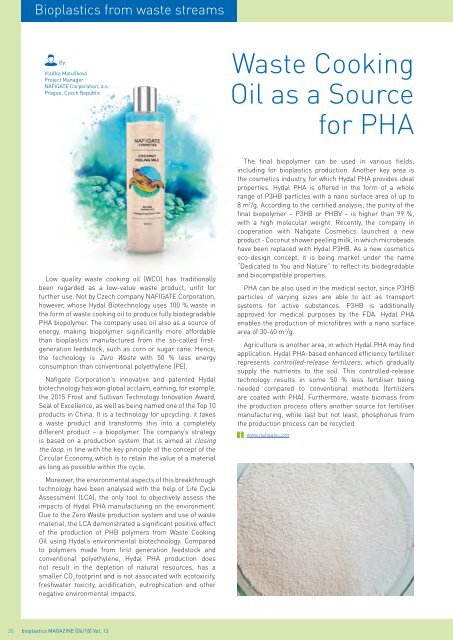Issue 06/2018
bioplasticsMAGAZINE_1806
bioplasticsMAGAZINE_1806
Create successful ePaper yourself
Turn your PDF publications into a flip-book with our unique Google optimized e-Paper software.
Bioplastics from waste streams<br />
By:<br />
Vlaďka Matušková<br />
Project Manager<br />
NAFIGATE Corporation, a.s.<br />
Prague, Czech Republic<br />
Waste Cooking<br />
Oil as a Source<br />
for PHA<br />
Low quality waste cooking oil (WCO) has traditionally<br />
been regarded as a low-value waste product, unfit for<br />
further use. Not by Czech company NAFIGATE Corporation,<br />
however, whose Hydal Biotechnology uses 100 % waste in<br />
the form of waste cooking oil to produce fully biodegradable<br />
PHA biopolymer. The company uses oil also as a source of<br />
energy, making biopolymer significantly more affordable<br />
than bioplastics manufactured from the so-called firstgeneration<br />
feedstock, such as corn or sugar cane. Hence,<br />
the technology is Zero Waste with 50 % less energy<br />
consumption than conventional polyethylene (PE).<br />
Nafigate Corporation’s innovative and patented Hydal<br />
biotechnology has won global acclaim, earning, for example,<br />
the 2015 Frost and Sullivan Technology Innovation Award,<br />
Seal of Excellence, as well as being named one of the Top 10<br />
products in China. It is a technology for upcycling: it takes<br />
a waste product and transforms this into a completely<br />
different product – a biopolymer. The company’s strategy<br />
is based on a production system that is aimed at closing<br />
the loop, in line with the key principle of the concept of the<br />
Circular Economy, which is to retain the value of a material<br />
as long as possible within the cycle.<br />
Moreover, the environmental aspects of this breakthrough<br />
technology have been analysed with the help of Life Cycle<br />
Assessment (LCA), the only tool to objectively assess the<br />
impacts of Hydal PHA manufacturing on the environment.<br />
Due to the Zero Waste production system and use of waste<br />
material, the LCA demonstrated a significant positive effect<br />
of the production of PHB polymers from Waste Cooking<br />
Oil using Hydal’s environmental biotechnology. Compared<br />
to polymers made from first generation feedstock and<br />
conventional polyethylene, Hydal PHA production does<br />
not result in the depletion of natural resources, has a<br />
smaller CO 2<br />
footprint and is not associated with ecotoxicity,<br />
freshwater toxicity, acidification, eutrophication and other<br />
negative environmental impacts.<br />
The final biopolymer can be used in various fields,<br />
including for bioplastics production. Another key area is<br />
the cosmetics industry, for which Hydal PHA provides ideal<br />
properties. Hydal PHA is offered in the form of a whole<br />
range of P3HB particles with a nano surface area of up to<br />
8 m 2 /g. According to the certified analysis, the purity of the<br />
final biopolymer – P3HB or PHBV – is higher than 99 %,<br />
with a high molecular weight. Recently, the company in<br />
cooperation with Nafigate Cosmetics launched a new<br />
product - Coconut shower peeling milk, in which microbeads<br />
have been replaced with Hydal P3HB. As a new cosmetics<br />
eco-design concept, it is being market under the name<br />
“Dedicated to You and Nature” to reflect its biodegradable<br />
and biocompatible properties.<br />
PHA can be also used in the medical sector, since P3HB<br />
particles of varying sizes are able to act as transport<br />
systems for active substances. P3HB is additionally<br />
approved for medical purposes by the FDA. Hydal PHA<br />
enables the production of microfibres with a nano surface<br />
area of 30-40 m 2 /g.<br />
Agriculture is another area, in which Hydal PHA may find<br />
application. Hydal PHA-based enhanced efficiency fertiliser<br />
represents controlled-release fertilizers, which gradually<br />
supply the nutrients to the soil. This controlled-release<br />
technology results in some 50 % less fertiliser being<br />
needed compared to conventional methods (fertilizers<br />
are coated with PHA). Furthermore, waste biomass from<br />
the production process offers another source for fertiliser<br />
manufacturing, while last but not least, phosphorus from<br />
the production process can be recycled.<br />
www.nafigate.com<br />
20 bioplastics MAGAZINE [<strong>06</strong>/18] Vol. 13


















